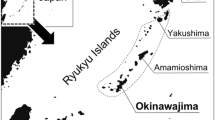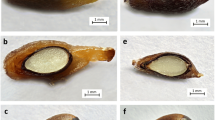Abstract
Germination traits of three Japanese Ulmus species, including two summer-fruiting species, U. davidiana var. japonica (UD) and U. laciniata (UL), and an autumn-fruiting species, U. parvifolia (UP), were investigated. Germination tests that controlled light (16 h dark–8 h light/24 h dark) and temperature (alternating 20–30°C/constant 23°C) conditions were conducted just after seed dissemination. Under the preferred (light and alternating temperature) conditions, UD germinated quickly and percentage germination was high (99%), whereas UL and UP germinated moderately to slowly (65.2 and 23.8%, respectively) and the remaining seeds were primarily dormant. When the seeds were exposed to unsuitable conditions for germination, secondary dormancy was induced in all three Ulmus species. Because primary and secondary dormancy of these species was not strict, the existing dormancy could be released by moist conditions and low temperature during the winter. Thus, all three Japanese Ulmus can germinate either just after seed dissemination or in the following spring. Nevertheless, the predominant germination of summer-fruiting UD just after seed dissemination seems to be advantageous for finding safe sites that might become available after a large-scale fluvial disturbance. Similarly, the delayed germination of autumn-fruiting UP until the following spring seems to be advantageous for preventing germination at the end of the growing season. Summer-fruiting UL had a more negative response to favorable light conditions just after seed dissemination, which seems to be advantageous for establishment in canopy gaps. These germination traits seem to be adaptive responses to the dominant disturbance regimes of their natural habitats.


Similar content being viewed by others
References
Abe M, Honda A, Hoshizaki K, Miguchi H (2008) Advantage of early seedling emergence in Fagus crenata: importance of cotyledon stage for predator escape and pathogen avoidance. Ecol Res 23:681–688
Augspurger CK (2008) Early spring leaf out enhances growth and survival of saplings in a temperate deciduous forest. Oecologia 15:281–286
Baskin CC, Baskin JM (1998) Seeds: ecology, biogeography, and evolution of dormancy and germination. Academic Press, San Diego
Baskin JM, Baskin CC (2004) A classification system for seed dormancy. Seed Sci Res 14:1–16
Bevington J (1986) Geographic differences in the seed germination of paper birch (Betula papyrifera). Am J Bot 73:564–573
Brinkman KA (1974) Ulmus L., elm. In: Seeds of woody plants in the United States. Agriculture Handbook 450, USDA Forest Service, Washington, DC, pp 829–834
Burns RM, Honkala BH (1990) Silvics of North America, vol 2. Hardwoods. Agriculture Handbook 654. USDA Forest Service, Washington, DC
Crawley MJ (1997) Plant ecology. Blackwell, Oxford
Donohue K (2003) Setting the stage: phenotypic plasticity as habitat selection. Int J Plant Sci 164:S79–S92
Fenner M, Thompson K (2005) The ecology of seeds. Cambridge University Press, Cambridge
Finch-Savage WE, Leubner-Metzger G (2006) Seed dormancy and the control of germination. New Phytol 171:501–523
Harper JL (1977) Population biology of plants. Academic Press, London
Higa M, Ishikawa S, Miyake N (2006) Ecological characteristics of Ulmus parvifolia, Celtis sinensis var. japonica and Aphananthe aspera on high and dry habitats of gravelly bars in rivers. Veg Sci 23:89–103 (in Japanese with English abstract)
Ito K (1989) Ulmus L. In: Satake Y, Hara H, Watari S, Tominari T (eds) Wild flowers of Japan: woody plants I (in Japanese). Heibonsya, Tokyo, pp 83–84
Johnson WC, Burgess RL, Keammerer WR (1976) Forest overstory vegetation and environment on the Missouri River floodplain in North Dakota. Ecol Monogr 46:59–84
Jones RH, Allen BP, Sharitz RR (1997) Why do early-emerging tree seedlings have survival advantages?: A test using Acer rubrum (Aceraceae). Am J Bot 84:1714–1718
Jurado E, Flores J (2005) Is seed dormancy under environmental control or bound to plant traits? J Veg Sci 16:559–564
Jurado E, Moles A (2003) Germination deferment strategies. In: Nicolas G, Bradford KJ, Come D, Pritchard HW (eds) The biology of seeds: resent research advances. CABI Publishing, Wallingford, pp 381–388
Koike T (1988) Leaf structure and photosynthetic performance as related to the forest succession of deciduous broad-leaved trees. Plant Species Biol 3:77–87
Kon H, Okitsu S (1999) Role of land surface disturbance in regeneration of Ulmus davidiana var. japonica in a cool temperate deciduous forest on Mt. Asama, central Japan. J Jpn For Soc 81:29–35 (in Japanese with English summary)
Koyama H (2002) Germination phenology of Japanese white birch (Betula platyphylla var. japonica) and its significance as adaptive strategy. Bull Hokkaido For Res Inst 39:1–38 (in Japanese with English summary)
Lopez OR, Farris-Lopez K, Montgomery RA, Givnish TJ (2008) Leaf phenology in relation to canopy closure in southern Appalachian trees. Am J Bot 95:1395–1407
Moles AT, Westby M (2004) What do seedlings die from and what are the implications for evolution of seed size? Oikos 106:193–199
Mori T (1998) Genus: Ulmus Linn. (Elm). In: Katsuta M, Mori T, Yokoyama T (eds) Seeds of woody plants in Japan: Angiospermae (in Japanese). Japan Forest Tree Breeding Association, Tokyo, pp 97–102
Nagamatsu D, Seiwa K, Sakai A (2002) Seedling establishment of deciduous trees in various topographic positions. J Veg Sci 13:35–44
Nakamura F (1990) Analyses of the temporal and spatial distributions of floodplain deposits. J Jpn For Soc 72:99–108 (in Japanese with English summary)
Nakamura F, Shin N, Inahara S (2007) Shifting mosaic in maintaining diversity of floodplain tree species in the northern temperate zone of Japan. For Ecol Manage 241:28–38
Nomiya H, Suzuki W, Kanazashi T, Shibata M, Tanaka H, Nakashizuka T (2003) The response of forest floor vegetation and tree regeneration to deer exclusion and disturbance in a riparian deciduous forest, central Japan. Plant Ecol 164:263–276
Ohno K (2008) Vegetation-geographic evaluation of the syntaxonomic system of valley-bottom forests occurring in the cool-temperate zone of the Japanese Archipelago. In: Sakio H, Tamura T (eds) Ecology of Riparian Forest in Japan: disturbance, life history, and regeneration. Springer, Tokyo, pp 49–72
Panetta FD (2001) Seedling emergence and seed longevity of the tree weeds Celtis sinensis and Cinnamomun camphora. Weed Res 41:83–95
Peterken GF, Moutford EP (1998) Long-term change in an unmanaged population of wych elm subjected to Dutch elm disease. J Ecol 86:205–218
Rees M (1994) Delayed germination of seeds: a look at the effects of adult longevity, the timing of reproduction, and population age/stage structure. Am Nat 144:43–64
Richens RH (1983) Elm. Cambridge University Press, Oxford
Sack L (2004) Responses of temperate woody seedlings to shade and drought: do trade-offs limit potential niche differentiation? Oikos 107:110–127
Sakai T, Tanaka H, Shibata M, Suzuki W, Nomiya H, Kanazashi T, Iida S, Nakashizuka T (1999) Riparian disturbance and community structure of a Quercus–Ulmus forest in central Japan. Plant Ecol 140:99–109
Sakio H (1997) Effects of natural disturbance on the regeneration of riparian forests in a Chichibu Mountains, central Japan. Plant Ecol 132:181–195
Sato H (1995) Studies on the dynamics of Pterocarya rhoifolia forest in southern Hokkaido. Bull Hokkaido For Res Inst 32:55–96 (in Japanese with English summary)
Schnitzler A (1994) European alluvial hardwood forests of large floodplains. J Biogeogr 21:605–623
Seiwa K (1997) Variable regeneration behavior of Ulmus davidiana var. japonica in response to disturbance regime for risk spreading. Seed Sci Res 7:195–207
Skordilis A, Thanos CA (1995) Seed stratification and germination strategy in the Mediterranean pines Pinus brutia and P. halepensis. Seed Sci Res 5:151–160
Suzuki W (2000) Germination traits and adaptive regeneration strategies of the three Carpinus species. J For Res 5:181–185
Suzuki W, Osumi K, Masaki T, Takahashi K, Daimaru H, Hoshizaki K (2002) Disturbance regimes and community structures of a riparian and an adjacent terrace stand in the Kanumazawa Riparian Research Forest, northern Japan. For Ecol Manage 157:285–301
Verdu M, Traveset A (2005) Early emergence enhances plant fitness: a phylogenetically controlled meta-analysis. Ecology 86:1385–1394
Wada M, Kikuchi T (2004) Emergence and establishment of seedlings of Japanese elm (Ulmus davidiana Planch. var. japonica (Rehder) Nakai) on a flood plain along the Azusa River in Kamikochi, central Japan. Veg Sci 21:27–38 (in Japanese with English abstract)
Walck JL, Baskin JM, Baskin CC, Hidayati SN (2005) Defining transient and persistent seed banks in species with pronounced seasonal dormancy and germination patterns. Seed Sci Res 15:189–196
Acknowledgments
I thank Wajirou Suzuki and Tatsuo Kanazashi for serving as mentors for this study. I am also grateful to Takuya Kajimoto, Tatsuya Ootani, Satoshi Saito, Masatake Araki, and Masazumi Kayama for valuable discussions. Hiroshi Tanaka kindly struggled to improve the manuscript to the final version. I also thank two anonymous reviewers for the kind and helpful comments on this manuscript.
Author information
Authors and Affiliations
Corresponding author
About this article
Cite this article
Nomiya, H. Differentiation of seed germination traits in relation to the natural habitats of three Ulmus species in Japan. J For Res 15, 123–130 (2010). https://doi.org/10.1007/s10310-009-0165-1
Received:
Accepted:
Published:
Issue Date:
DOI: https://doi.org/10.1007/s10310-009-0165-1




